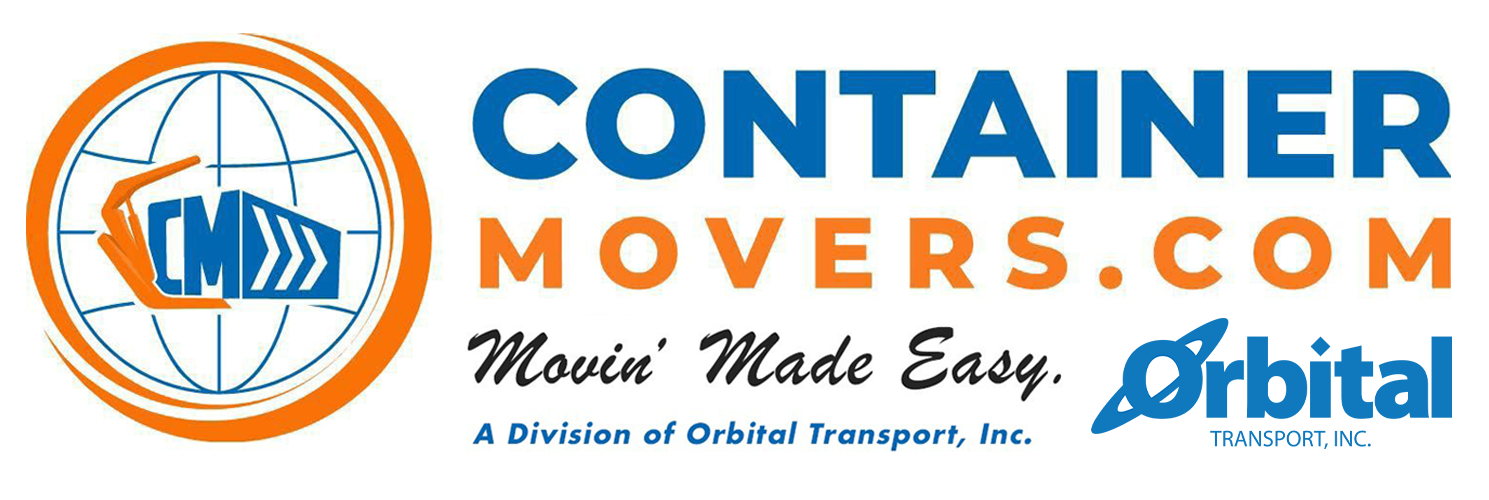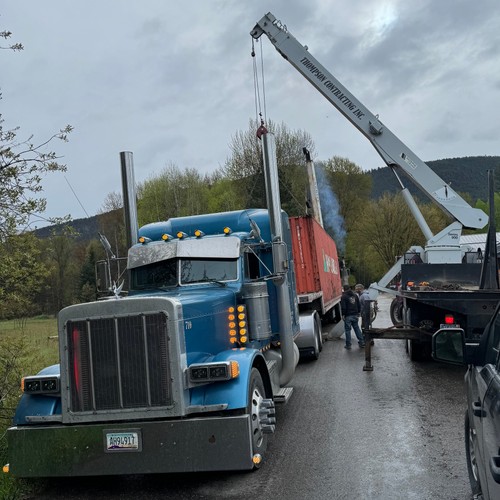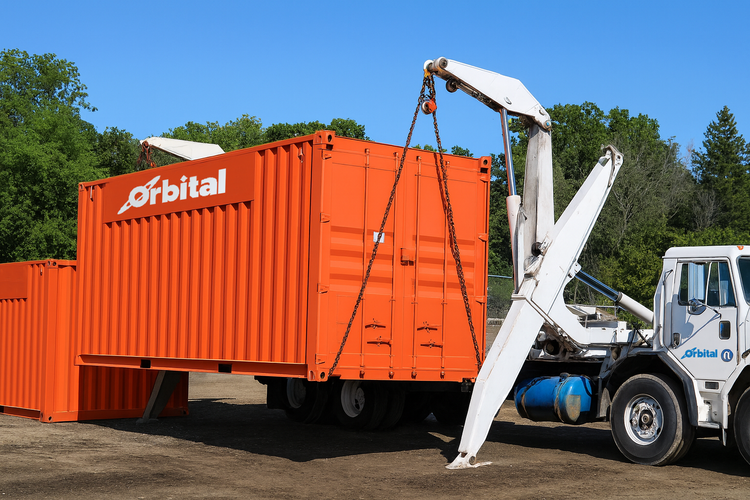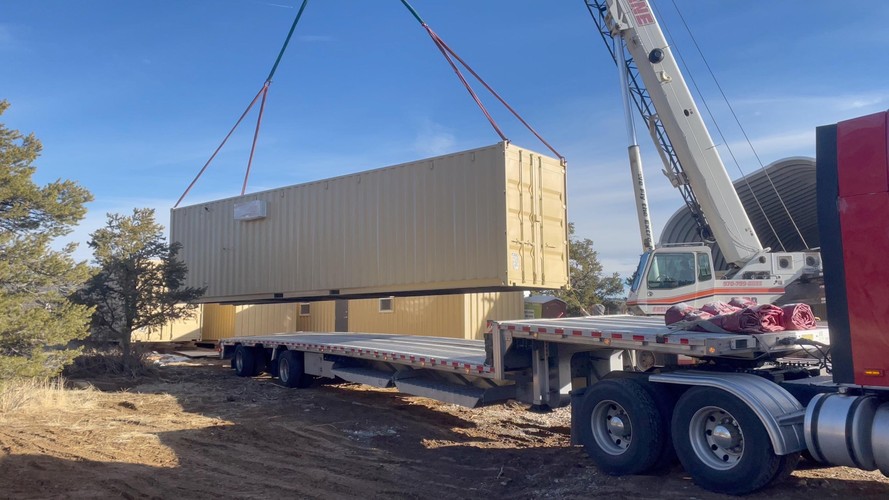Crane and Side Loader Container Moving Services Across the US
From trucking to cranes to scheduling, we’re the single point of contact for stress-free container moves.
Crane and Side Loader Container Moving Services
Looking for crane and side loader container services near me? You’re in the right place. We provide full-service shipping container moving solutions across the United States – handling everything from trucking and cranes to scheduling and site prep. Our team’s goal is to make relocating a container easy and stress-free for you. On this page, we’ll break down the technical side of our equipment, the scope of our services, the industries we serve, and how we coordinate the entire process. We’ll also answer some common FAQs. By the end, you’ll see why we’re the single point of contact (the “ringmaster,” if you will) for all your container moving needs.
Technical Overview: Side Loaders, Rotator Trucks, and Heavy Cranes
Moving heavy shipping containers requires specialized equipment. We utilize a range of cranes and lifting machines to get the job done safely and efficiently, including side loader trucks, rotator trucks, and heavy lift mobile cranes. Each type has unique capabilities and use cases. Below is an overview of how these machines work, their lift capacities, typical applications, and the safety standards we follow.
Side Loader Trucks (Self-Loading Container Trailers) Overview
Side loaders – also known as side lifters or swinglift trucks – are purpose-built to lift and transport containers from the ground up onto a trailer (or off of one). A side loader trailer has two hydraulic lifting arms (mini-cranes) mounted at each end of the chassis. These arms latch onto a container’s corners and hoist it up vertically, then gently lower it onto the trailer or ground next to the truck. This allows a single truck to load or unload a container without any additional equipment.
Hit the buttons on the right to discover all the details!
Side loaders are ideal for situations where you need to transfer containers between ground and truck. For example, if you have a storage container at ground level that needs to be loaded onto a flatbed or chassis for transport, a side loader can do it quickly. They’re commonly used for delivering empty or loaded shipping containers to worksites, homes, or storage yards where no loading dock or crane is available.
Our side loader units can safely lift fully loaded ISO containers – typically up to around 35 tons (about 70,000 lbs). They can handle loaded 20′, 40′, and even 45′ containers (up to ~73,000 lbs of cargo plus the container weight) and set them at ground level with stability. Despite their heavy lifting power, side loaders are relatively compact and operate right from the truck’s side. They do require sufficient clearance (roughly the container’s length) alongside the truck to set the box down. The ground should be fairly level and firm for the outriggers to stabilize the trailer during lifts. With the proper setup, a side loader can complete a container load or unload in just minutes, often 5–10 minutes per container. This efficiency, plus the fact that only a single operator is needed, makes side loaders a popular choice for quick container transfers.
When using a side loader, we’ll advise you to ensure there’s a clear, level area next to the truck where the container will be placed. We position the truck parallel to the drop spot, extend the hydraulic outriggers for stability, and then lift the container smoothly. Compared to a standard crane, side loaders need less space and have a lower profile, which can be helpful in urban or low-clearance environments.

Rotator Crane Trucks (High-Maneuverability Lifting) Overview
Rotator trucks are heavy-duty wrecker tow trucks equipped with rotating booms – essentially, they are like mobile mini-cranes mounted on a truck chassis. Unlike side loaders (which lift from both ends), a rotator uses a single telescopic arm with chains or slings to lift a container from a central point. The boom can then rotate 360°, allowing the operator to swing the suspended container and set it down in a more flexible radius around the truck. Rotators offer a bit more placement flexibility than side loaders, which makes them useful in tight or uneven spaces where a side loader might not be able to park directly alongside the container.
Hit the buttons on the right to discover all the details!
We call in rotator crane trucks for scenarios that need creative maneuvering or one-end lifts. For example, if a container must be lifted off a trailer and placed in a spot with limited side access, a rotator can hoist it and swivel to position it precisely. Rotators are also handy for recovering tipped or stuck containers, or for lifting containers in confined urban areas where deploying a large crane isn’t feasible. Essentially, whenever we need crane-like capability but with the mobility of a truck, a rotator is an excellent solution.
Don’t underestimate these trucks – modern rotator wreckers have impressive lifting power. Our network includes rotator units in the 50-ton to 75-ton class, and even the largest rotator tow trucks are rated up to 100 tons of lifting capacity. In practical container moving terms, this means a rotator can handle standard loaded containers with ease, similar to a side loader’s range, and even perform heavy lifts within its radius. The rotator’s boom, however, has a limited reach (usually best for lifts relatively close to the truck). It excels at lifting a container off a truck bed and rotating it to the ground nearby or vice versa. Like any crane, its effective capacity decreases the further out it has to reach, so very large offset distances might require a bigger dedicated crane. Rotators also deploy outriggers for stability during lifts, so they need a bit of room to set up (typically a wider footprint than a side loader, but still far less than a large crane).
When we use a rotator, we’ll assess the approach path and rotation clearance. The truck might back up perpendicular to the drop spot or at an angle, then extend its outriggers. We ensure the ground is solid under the truck and outriggers. One advantage of rotators is they can often operate on the street and swing a container into a fenced yard or over a small obstacle (like a ditch or curb), all without a separate crane. This makes them very adaptable. Our team will plan the lifting angle and make sure there’s no overhead obstruction in the boom’s swivel path. Safety is paramount – even though rotators are highly stable, we only lift within the safe working load and radius as specified by the manufacturer.

Heavy Lift Mobile Cranes (High-Capacity Rigging) Overview
For the most challenging jobs, we tap into our network of professional mobile cranes – ranging from truck-mounted telescopic cranes to large all-terrain cranes and even boom cranes or forklifts when appropriate. These are the kinds of cranes you might see on construction sites, capable of lifting far beyond container weights and reaching significant heights. If a container needs to be placed on a high rise building, lifted over a house into a backyard, or if it’s an extraordinarily heavy or oversize unit, a heavy crane is the tool for the job.
Hit the buttons on the right to discover all the details!
We typically bring in heavy lift cranes for precision placements and hard-to-reach locations. Some examples:
- Hoisting a container over a building or onto a rooftop (common in downtown construction or high-rise projects).
- Setting containers inside building foundations or basements for infrastructure work.
- Lifting modular container home sections onto pile foundations or stacking them for multi-story configurations.
- Any situation where the container’s placement point is not immediately adjacent to where a truck can go (the crane provides the extended reach).
Through our nationwide partners, we have access to cranes of virtually any size needed. Our crane fleet ranges from smaller 3-ton knucklebooms up to 100-ton giants. For context, a standard loaded 40′ steel container might weigh on the order of 20–30 tons; even our mid-size mobile cranes (e.g., 50-ton class) can lift that with plenty of margin. For extremely heavy loads or unusual lifts, we simply dispatch a larger crane. The key advantage of using a dedicated crane is the ability to reach high or far – booms can extend dozens of feet in the air (some over 50 feet or more), and they can place a container precisely where needed, even if that’s on a rooftop or over a barrier. Of course, heavy cranes require more logistics: we might need to arrange road access for the crane, ensure the ground can support it, and sometimes use spreader bars or special rigging gear to attach to the container’s corner castings.
Using a crane for container delivery involves careful planning. Our team will survey the site (often via photos or a visit) to determine the best crane setup location. Overhead clearance is checked – we look for power lines, tree branches, or roof eaves that the crane or hanging container must avoid. A crane needs ample room to extend its boom and swing the container safely, so we ensure there’s a clear arc path. We also analyze ground stability: the crane’s outriggers must sit on firm, level ground (we can deploy outrigger pads or crane mats if needed) because soft or uneven ground can cause shifting – a serious safety hazard. If the site is tight, we might use a smaller crane or a rotator as an alternative, but if a big crane is the only way, we will coordinate any necessary permits (for road closure or sidewalk use, for instance) and make sure everything is ready for a safe lift day. When the crane arrives, expect a bit of setup time: the operator will extend the outriggers, we’ll rig the container (usually attaching four straps or chains to the container’s corner fittings), and then the crane will lift the container into place.

Safety and Compliance Standards
Safety is built into every step of our crane and side loader operations. We adhere to strict OSHA guidelines and industry standards for lifting, rigging, and transportation. All our crane operators are licensed and certified (e.g., NCCCO-certified in the U.S.) to ensure expert handling of equipment. Every lift is carefully planned and executed within the rated limits of our machinery – we always verify the container weight and use the appropriate crane with a proper load chart.
-
Certified Equipment: Cranes and side loaders undergo regular inspections and maintenance. All gear is compliant with applicable standards.
-
Proper Rigging: Approved lifting points on the container with correct shackles and straps. Crew double-checks all connections.
-
Site Risk Assessment: Ground firmness, wind conditions, and obstacles are evaluated. Weather-related delays are implemented as needed.
-
Compliance and Permits: DOT regulations and overweight/oversize permits are managed nationwide to ensure legal and safe transport.
-
Trained Crew and Communication: Certified operators and ground crew maintain clear communication and safe distances throughout every lift.


By following these standards, we ensure that every container move is executed safely and in compliance with all regulations. Our reputation depends on doing things the right way – and we’re proud to say we’ve maintained a spotless safety record. Bottom line: your container (and property) are in safe hands with us.
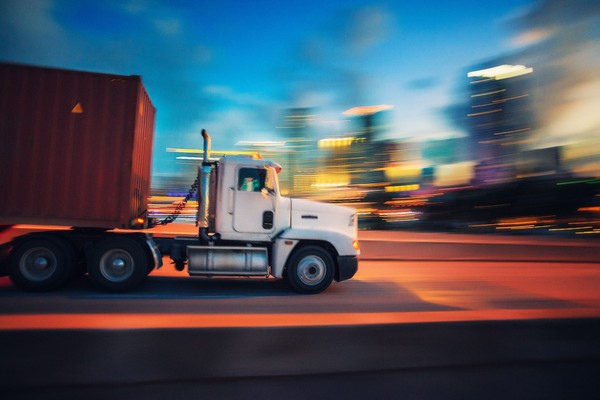
Nationwide Availability & Rapid Mobilization
We provide nationwide container moving services, meaning no matter where you are in the U.S., we can help get your container moved. Thanks to our extensive equipment network, we offer local service on a national scale – perfect for anyone who’s searched for a “container crane rental US” solution or “nationwide container moving services” that can reach them. Here’s what you can expect from our service scope:
Coast-to-Coast Coverage:
Whether your container is in a busy port city or a rural farm, we have you covered. Our network of side loader trucks, rotator wreckers, and crane partners spans all 50 states. We’ve coordinated container moves in dense urban centers, remote oil fields, mountain towns – you name it. When you contact us, we tap into the nearest reliable operators and equipment to assist you wherever “near me” happens to be. This eliminates the headache of you trying to find specialized container equipment in your area – we’ve already done that legwork for you.
Fast Turnaround (Typical 1–2 Day Job Completion):
We pride ourselves on rapid response and quick job completion. In most cases, we can schedule and complete a standard container move within one to two days. For example, if you call us on a Monday, it’s not unusual that by Tuesday or Wednesday your container will have been picked up and delivered to its new location. We achieve this speed by streamlining coordination: once you give us the go-ahead, we immediately arrange the trucking and lifting equipment and secure any needed permits. Our dispatch team is excellent at finding the earliest available slot that works for you. Of course, more complex jobs (or long-distance hauls) might take a little longer, but even then we move with urgency. We know that when you need a container relocated, you usually need it done soon – and we’re set up to make that happen. If you have an urgent timeline, let us know and we’ll do everything we can to expedite the move.
Rapid Mobilization & Extended Equipment Network:
One of our key strengths is the ability to mobilize the right equipment quickly. Because we maintain relationships with crane operators and trucking fleets nationwide, we can pull the necessary resources together in short order. For instance, if your job requires an 80-ton crane in a remote area, we’ll reach into our network, find the closest crane of that capacity, and get it on the schedule. This extended network means we’re not limited to one set of trucks or a single yard – we have flexibility to adapt. It also means if unexpected issues arise (say, a crane we planned to use becomes unavailable last-minute), we can swiftly find a replacement with minimal delay. Our nationwide approach basically brings “crane and side loader container services near me” to your doorstep by leveraging local partners under our coordination.
Full-Service Convenience:
A major benefit of working with us is that you don’t have to rent equipment separately or manage multiple vendors. Many customers initially wonder if they need to rent a side loader for container delivery on their own or hire a crane themselves – with us, that’s not necessary. We provide the trucks, side loader, crane, and any other gear as part of our service. It’s truly a one-stop solution. Even if you simply needed to rent a container lifting machine, contacting us is a smarter route, because you’ll get a certified operator and support team along with the equipment. We take care of all the logistics, so you can focus on what’s inside the container and leave the container crane rental and coordination to us.
It’s worth noting that while we specialize in end-to-end moves (handling the entire process), we are flexible to your needs. On occasion, clients approach us who have their own truck or trailer but just need a crane to unload at the destination (or vice versa). We typically bundle our crane services with transport, but if you only require crane service without trucking, it is possible for us to arrange that. Thanks to our nationwide crane network, we can dispatch a qualified crane crew to your site even if we’re not hauling the container ourselves. Our goal is to be helpful and solution-oriented – so whatever the scope (full move or partial assist), feel free to reach out and we’ll accommodate if we can.
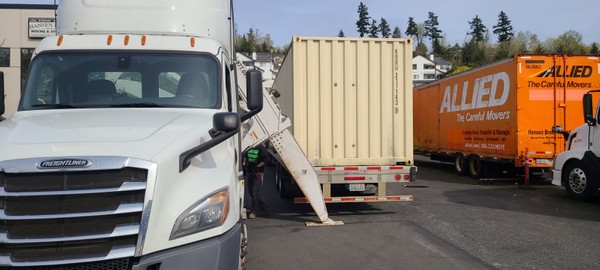
Industry Applications and Use Cases
Our crane and side loader container services support a wide range of industries and projects. Wherever heavy containers need to be moved, lifted, or placed, we likely have experience doing it. Here are some of the industry applications and scenarios where our services are commonly used:
Construction & Infrastructure
Construction sites often use shipping containers as mobile storage units or onsite offices. We deliver containers loaded with tools, materials, or equipment directly to jobsites – even placing them on difficult terrain or upper levels of a site if needed. Infrastructure projects (roadworks, bridges, etc.) may require generators or control equipment housed in containers; we can set those in position. Our fast 1-2 day turnaround fits the tight schedules of construction projects, minimizing downtime waiting for a container to arrive or be moved.
Energy, Mining & Water Treatment
Remote energy and mining operations frequently rely on containerized units – whether it’s a portable office, a water treatment system in a container, or heavy machinery that’s been packed into a container for transport. We have nationwide reach to serve oil fields in Texas, wind farms in the Midwest, mining sites in Nevada, or solar farms in remote areas. We coordinate the complex logistics required to get containers to isolated locations, using side loaders or cranes to unload on rough terrain. In the utilities sector (water treatment plants, pump stations), we move specialized container modules into place for installation.
Events, Trade Shows & Racing
Event organizers use shipping containers in creative ways – pop-up shops, ticket booths, storage for equipment, even stages and backdrops. We help with the logistics of events and trade shows by delivering and positioning containers at venues. For example, a motorsport racing team might use a container as a mobile garage or parts storage at the track – we’ll haul it in, then use a crane or side loader to set it right in the pit area. At trade shows or concerts, we’ve placed containers that were converted into promotional booths or VIP lounges. Timing is critical in events, so our rapid mobilization ensures your container arrives exactly when and where it should, and we’ll pick it up promptly when the event is over.
Fire & Rescue Training
Fire departments and emergency services often build training facilities out of shipping containers (for simulations of burning buildings, search-and-rescue mazes, etc.). We assist by delivering and stacking containers for these training structures. For instance, we can use cranes to create a multi-level stack of containers for a fire training tower, or place single containers in various configurations to simulate different disaster scenarios. Because safety is crucial, we make sure each container is precisely placed and stable. We’ve worked with municipal agencies to schedule these moves during off-peak hours and coordinate any special requirements on site (some training yards are in tight urban locations, which we handle accordingly).
Modular Housing & Container Homes
The trend of container homes and modular buildings means moving finished container modules to residential or commercial sites. These containers-turned-houses often need gentle handling and precise placement onto foundations or piers. Our team is experienced in working with architects and builders to cranially set container home modules. We’ll lift the container home off the delivery trailer and onto your foundation with utmost care, ensuring alignment is perfect. For multi-unit builds, we can stack containers as designed. We understand these units may have interior finishes and delicate components, so we treat them with the same caution as we would a piece of high-tech equipment. From a single backyard container office to a multi-container apartment project, we help bring these structures to life in their final location.
Manufacturing & Industrial Clients
Many industrial companies use large ISO containers to house expensive machinery (think generators, compressors, CNC machines, or entire workshop setups). We frequently move such containers for mechanical contractors, factories, and plant relocations. If a factory is retooling and needs to swap out a containerized system, we’ll handle the extraction and replacement. We also work with logistics providers to perform transloading – for example, lifting a heavy machine inside a container from one truck to another type of transport (flatbed, rail, etc.). Our heavy crane capabilities really shine for industrial moves, as we can rig and lift oversized or overweight containers that standard equipment can’t. We ensure minimal disruption to your operations by coordinating moves during planned shutdowns or off-hours when necessary.
These are just a few examples – truthfully, the applications are endless. From government and military uses (moving CONEX containers for deployment exercises) to agriculture (placing containerized farm equipment or storage on fields), we’ve pretty much done it all. If you have a unique scenario involving a container, feel free to reach out. We love a good challenge and will apply our expertise to your specific industry needs.
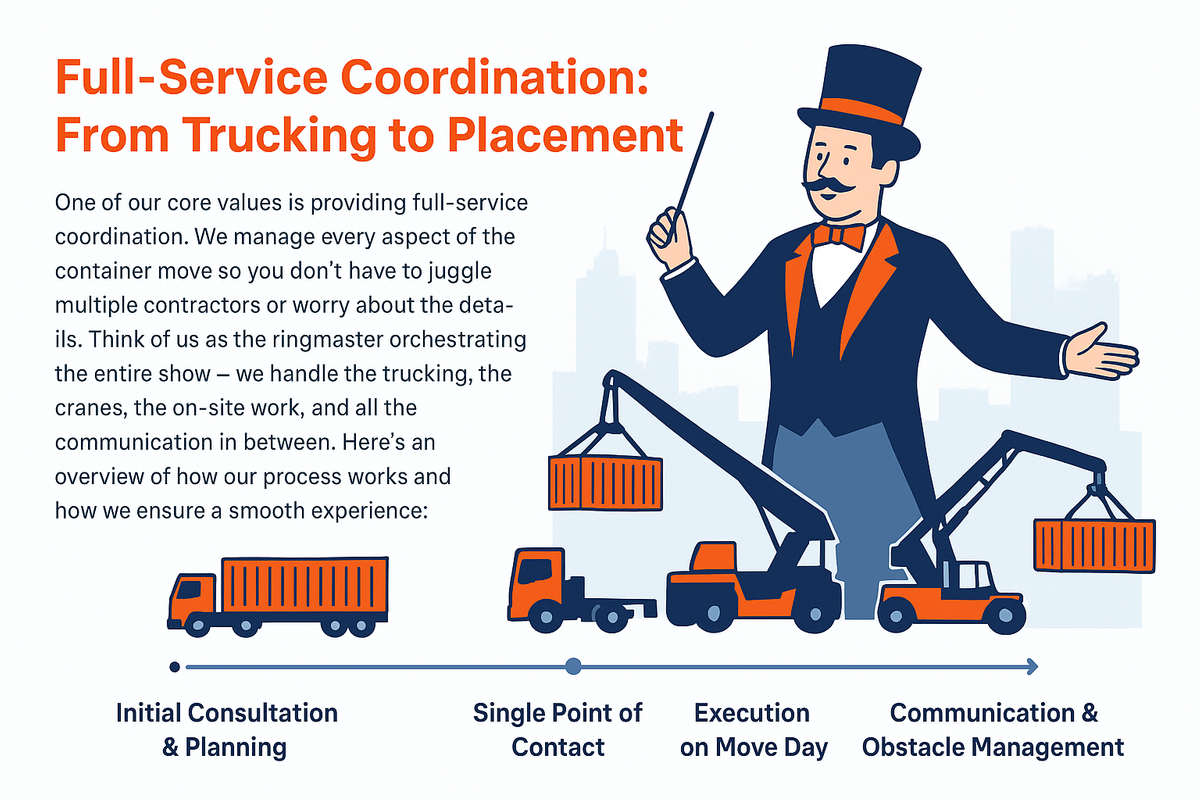
Full-Service Coordination: how our process works and how we ensure a smooth experience
Initial Consultation & Planning
It often starts with you telling us what you need – for instance, “I have a 20’ container in my backyard that I need moved to a new site across town,” or “We need to lift a containerized generator onto a platform at an industrial plant.” We’ll ask a few questions about the container’s size, weight (loaded or empty), pickup and drop-off locations, and any site quirks you know of (e.g. “the container is behind a building” or “there’s a narrow driveway”). With that info, our experts determine the best equipment and plan for the job. We’ll coordinate the trucking (selecting the right truck or trailer to haul the container) and the lifting method (deciding between side loader, rotator, or crane based on the situation). If permits or special considerations are needed, we start arranging those now. Essentially, we create a step-by-step plan and schedule for move day.
Single Point of Contact
Once planning is done, we assign you a dedicated point of contact – usually the logistics coordinator managing your move. This person is your one call does it all contact. They will schedule the truck pickup, book the crane/side loader and crew, and organize on-site timing. If you have questions or changes, you only need to communicate with your rep, and they handle passing instructions along to all parties. We emphasize this because it significantly reduces miscommunication. Instead of you calling a trucking company, then separately calling a crane company and trying to synchronize them, we do all that. Your point of contact will keep you updated as your move progresses. On the day of the move, they’ll confirm when the driver is en route, when the crane is set up, etc. It’s our job to coordinate on-site scheduling so that everything happens efficiently – for example, timing the truck’s arrival with the crane’s setup so neither is waiting on the other.
Execution on Container Moving Day
When the day arrives, our team swings into action. The truck driver will arrive at the pickup location at the appointed time. If we’re using a side loader, the side loader truck is the hauler, so it will lift the container and then transport it directly. If we’re using a separate crane, the sequence is typically: the truck positions itself for loading (or unloading), and the crane (or rotator) is set up nearby. We handle all the on-site logistics – positioning vehicles, extending outriggers, attaching rigging – in a safe and methodical way. We often have a supervisor on site who ensures that the truck driver, crane operator, and any riggers are all in sync. You are welcome to watch or give us any specific placement instructions (like “rotate the container so the doors face the fence,” etc.). We love getting the placement exactly how you envision it.
Communication & Obstacle Management
Communication is constant throughout the process. If any potential issue comes up, we inform you right away and present solutions. For instance, if at the delivery site we find an unexpected obstacle (maybe another vehicle is parked where the container needs to go), we’ll discuss alternatives or adjustments. However, we strive to prevent common obstacles through thorough planning. Here are some typical challenges and how we mitigate them:
- Overhead Obstructions: We always survey for overhead power lines, low tree branches, or building overhangs that could interfere with a lift. Cranes need room to swing a container safely without hitting anything. If overhead lines are present, we might choose a different offload spot or use a smaller rotator that can maneuver under the lines. In some cases, we coordinate with utility companies to temporarily shield or de-energize power lines if a lift must take place nearby (safety first!). By identifying these hazards beforehand, we avoid dangerous last-minute surprises.
- Ground Conditions: We check the ground where the truck and crane will operate. Soft soil, recently rained-on mud, or uneven grades can be problematic. Crane outriggers must sit on a firm, level surface to prevent any shift or sinkage during the lift. If needed, we’ll bring timber mats or steel plates to distribute the load on soft ground. If the site is on a slope, we position equipment in the safest orientation and use leveling techniques. In extreme cases of poor ground (e.g. a container in a muddy field), we might deploy a rotator or a rough-terrain crane designed for such conditions. Our goal is to ensure stability at all times.
- Tight Access or Space Constraints: Not every container is sitting in an open lot – we often face narrow driveways, gated yards, or building corridors. Our approach is to match the equipment to the space. For example, if a 40’ trailer can’t get close, we might use a smaller tilt-bed truck to pull the container out to the street first. Or if there’s no room to set a container beside a truck, we’ll use a crane to lift it over an obstacle. In planning, we often ask for site photos or even use Google Earth to assess the layout. This helps us choose, say, a rotator truck if there’s only one-side access, since it can lift and swing the container in a tight area. We also instruct drivers on the exact approach path to minimize any risk of getting stuck. By simulating the move in our heads (or on paper) beforehand, we navigate tight spots smoothly.
- Permits and Regulations: If your container move involves crossing state lines, oversize dimensions, or setting up a crane on a public road, rest assured we handle the paperwork. For example, moving an oversize container (like a 45’ high-cube with extra height) may require a road permit – we’ll obtain that. Setting a crane on a city street might need a temporary road closure permit – we arrange it and schedule off-peak hours to do the work, causing minimal disruption. Our familiarity with these regulations means we proactively take care of them, so there are no legal or bureaucratic holdups on move day. All our transport vehicles are properly licensed and insured as well.
- Weather and Other Delays: While we can control logistics, we can’t control Mother Nature. If a sudden storm, high winds, or lightning strike risk emerges on the scheduled day, we’ll communicate with you immediately. Safety might dictate rescheduling the lift portion (for instance, cranes generally don’t operate in high winds or thunderstorm conditions). We keep a close eye on the forecast and often have backup windows in mind. Our coordinator will ensure you’re informed and work out a new plan if needed. We know your time is valuable, so we don’t make these decisions lightly – only if it’s truly necessary for safety. In all cases, we keep you in the loop, so you’re never left wondering about the status.
Through all these steps, our focus is on coordination and communication. We want you to feel confident that your container move is being handled professionally. Many clients tell us they were amazed at how easy we made it – they expected a stressful ordeal, but with us managing everything, it turned out to be simple. That’s music to our ears. By being proactive about obstacles, keeping everyone on schedule, and updating you regularly, we ensure a successful, stress-free move for your container.
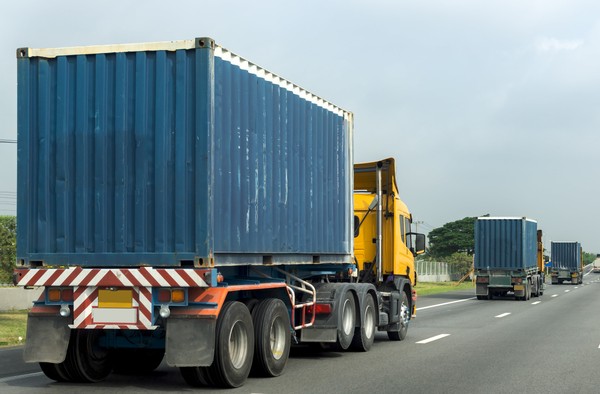
FAQ: Container Moving Services
Below we answer a few frequently asked questions regarding our crane and side loader services for moving containers. If you have a question not covered here, please don’t hesitate to contact us – we’re always happy to provide more information.
Frequently Asked Questions
Yes, absolutely. We can load shipping containers onto flatbed trucks or standard chassis trailers whenever needed. Our side loader trucks are especially handy for this – they can lift a container from the ground and set it directly onto a waiting flatbed or chassis, effectively acting as a mobile loading crane. This means if you have a container at ground level that needs to travel a long distance on a flatbed, we’ll dispatch a side loader to pick it up and load it safely. The reverse is true as well: if a container arrives on a flatbed, we can use the side loader to unload it to the ground. By using the proper equipment, there’s no need for a loading dock or forklift – we take care of the heavy lifting. This capability is part of our full-service approach, saving you from having to hire separate equipment just to get a container on or off a truck.
We can handle pretty much any container weight in the normal range, and then some. Our side loader units can typically lift up to around 35 tons, or roughly 70,000–73,000 pounds – which covers a fully loaded 40-foot shipping container (plus a safety margin). For example, if you have a 40′ steel container loaded with machinery or goods, our side loader can lift and carry it without issue. Rotator trucks have similar capacity for standard container jobs, with heavy-duty rotators rated even higher (50+ tons capacity). And for heavier-than-usual loads or special situations, we deploy larger mobile cranes from our network. We have access to cranes rated well over 100 tons, so lifting extremely heavy containers or equipment is within our capabilities. In short, whether your container is empty (5,000 lbs) or packed to the brim (60,000+ lbs), we will utilize the appropriate equipment to lift and move it safely. We always verify the container’s weight beforehand to ensure we send the right rig. Rest assured, there’s virtually no shipping container too heavy for us to manage with our range of cranes and side loaders.
In general, a typical container move with us is completed within 1–2 days from the time you confirm the job. The exact timeline can vary depending on distance and scheduling, but here’s how it usually breaks down: Once you place an order, we often can arrange pickup of the container the very next day (sometimes even the same day if logistics allow and it’s urgent). The actual on-site loading and unloading process is very quick – often under an hour at each end, since our equipment makes fast work of lifting the container. If the destination is within a few hundred miles, we often perform pickup in the morning and delivery by that afternoon or the following morning. For longer cross-state moves, the transit might add an extra day, but we still strive to complete the entire operation promptly. We coordinate closely with you on scheduling; if there are specific site access times or business hours to work around, we factor that in. The bottom line is we know you want your container moved ASAP, so we focus on efficiency. Thanks to our ready-to-deploy network, we don’t keep you waiting weeks – a couple of days is usually all it takes for a smooth container relocation. And throughout the process, our team will keep you updated on the schedule (e.g. “your container will be picked up Tuesday 9 AM and delivered by 1 PM” etc.), so you’re never in the dark about timing. Feel free to contact us for any further questions or to get a quote on your container move. We’re here to help with friendly, professional, and fast service nationwide!

Our Pros will Share the Load
When it comes to moving portable, loaded, or empty shipping containers/conex boxes, leave the logistics to the pros at Container Movers. If it’s in a shipping container, we'll pick it up and deliver it—safely and efficiently. Whether you're relocating small storage boxes, large modular office trailers, or shipping containers across state lines, our mobile services are designed to meet your needs with precision and reliability.
Container Movers Near Me
If you're searching for “container movers near me,” look no further. We specialize in seamless container delivery, loading, unloading, and transport services, handling everything from portable cargo carriers to complex intermodal trucking operations. At Container Movers, we understand the complexities of container logistics and provide professional guidance to ensure your goods are transported securely.
Businesses & Individuals
Our solutions are ideal for businesses and individuals requiring flexible and dependable transportation services. Whether you need to move a 20ft or 40-foot container, our expert team is here to simplify the process and take the hassle out of freight transport.
If you have questions about your shipping or storage container transport, contact us today. We’re here to provide reliable, cost-effective solutions to get your container moved safely and on time.
